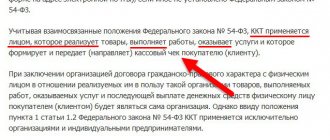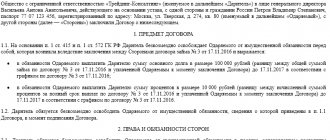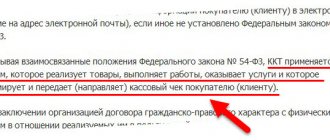Grounds for debt forgiveness by the founder
Debt forgiveness
- this is a firmly and clearly expressed will of the creditor to release the debtor from fulfilling obligations to repay borrowed funds and/or interest and penalties on the loan.
The possibility of debt forgiveness is provided for in Article 415 of the Civil Code of the Russian Federation. However, there is a caveat - writing off the debt should not affect the interests of third parties and the debtor. That is, if a debtor company objects to the forgiveness of its debt obligations, the creditor cannot carry out the write-off procedure on its own - such a transaction is not unilateral.
Moreover, if the creditor company refuses to accept funds to repay the debt, the debtor has the right to transfer the money to the account of a notary or judicial authority.
It is clear that since the founder himself manages his company, acting as a debtor, he will not interfere with debt forgiveness. However, in such a situation it is important to think about the interests of third parties. For example, you should check whether the interests of creditors to whom the founder himself has debt obligations will not be affected.
Creditors may be interested in the possibility of collecting debts from the assets of the business, including from the proceeds of a loan that was supposed to be forgiven. The lender may demand repayment of the debt by:
- destruction of the loan agreement from the founder;
- delivery of a promissory note;
- sending an official mail notification.
Important!
The debt can be forgiven by the founder in whole or in part.
Before executing a debt forgiveness transaction, the creditor must notify the debtor of his offer in writing. If he sends a letter of objection, debt forgiveness cannot be carried out. If the debtor does not take any actions that could be regarded as objections, or agrees to the transaction, the paperwork can begin.
Reasons
This process is carried out in accordance with the civil code of the Russian Federation. The rules of civil law regulate the procedure for the founder to forgive the debt of his company. The article indicates the possibility of the creditor to release the debtor from obligations, but it is emphasized that the debtor has the right not to accept such an offer from the creditor, that is, this type of transaction is not unilateral. If the creditor refuses to accept funds in payment of the debt, the debtor may deposit the funds into the account of the court or notary. The founder has the right to forgive the debt of his company if the rights of other persons are not violated. This category of persons includes, for example, creditors to whom the founder has debt obligations.
Determining the rate in the loan agreement
Interest-free loans issued to subsidiaries are risky because the lender will be required to pay interest.
In this regard, it is strongly recommended to indicate the interest rate in the loan agreement - this approach is beneficial to the borrowing organization, since interest on the loan is taken into account in order to reduce the tax base for income tax.
Subsequently, the founder signs an agreement to forgive the debt. When the share in the authorized capital owned by the lender turns out to be more than 50%, the amount will not be included in the tax base.
List of required documents
The procedure for obtaining a loan between the founder and the business entity must be accompanied by the following documentation:
- agreement for the provision of borrowed funds
- documentation certifying the receipt of the amount of money specified in the agreement from the lender to the borrower
The loan agreement does not require notarization. To formalize the agreement, the following documents are required:
- civil passports of the founders and director
- statutory documentation
- OGRN, INN
- information from the Unified State Register of Legal Entities
- If there is collateral, you will need documentation for it
If an agreement is concluded between an individual and a business entity, then it must contain the following information:
- loan amount in rubles
- purpose of providing funds
- order and parameters of its return
- accrued interest
- presence of penalties
The agreement must indicate the procedure for calculating interest or the fact of its absence. Today the following methods of debt repayment are used:
- One-time deposit of funds before the day specified by the concluded agreement. If there is interest, the borrower must pay the principal amount and interest on it.
- Debt repayment is carried out in accordance with the schedule determined by the terms of the agreement (once a week, month, quarter).
- The debt is returned upon presentation of a claim from the lender.
Due to the fact that funds are used to develop their own business, collateral is usually not issued. For the founders, the order in which the funds lent are spent is of great importance. Each of the participants can exercise control over the use of money without being part of the company's management.
List of documents on video:
If the borrower does not comply with the terms of the agreement, the lender may go to court. In this case, the borrower will have to not only repay the existing debt and interest on it, but also reimburse legal costs and pay fines to the creditor.
Thus, the procedures for providing and receiving borrowed funds require mandatory recording in the accounting system. If there is interest for using the loan, their accrual is recorded in separate transactions.
Top
Write your question in the form below
How to apply for debt forgiveness by the founder - legal procedure
The procedure for debt forgiveness by the founder can be formalized in several ways:
| Method for completing a debt forgiveness transaction | The essence of the method |
| Conclusion of an agreement according to which the subject of the transaction will be the release of the debtor from his debt obligations to the founder. | Such a document must be submitted to the lender by the borrower at the time of receipt of borrowed funds from him. The text of the agreement must refer to Article 415 of the Civil Code of the Russian Federation. The text of the agreement is formed in any form, but it is necessary to indicate the amount of the debt written off, the name of the organization, details of the parties to the agreement, details of the loan agreement under which the company received a loan from the founder. |
| Conclusion of an additional agreement between the debtor and the founder. | The subject of such an agreement is the founder’s waiver of the right to collect debt from the debtor organization. This document does not cancel the debt, but allows you not to repay borrowed funds without causing legal consequences. |
| Execution of a gift agreement, the parties to which are the founder-lender and the debtor company, and the subject is the amount of debt. | This method is only possible if the founder is an individual. The law prohibits two legal entities from gifting assets to each other. A donation agreement can be concluded:
|
Legal procedure
In accordance with legal norms, this procedure for forgiveness of debt by the founder can be formalized using different methods. Let's take a closer look at them.
The first method is to draw up a gift agreement, in which the parties are the founder and the company itself. The subject of the agreement in this case is the amount lent to the company. This option of debt forgiveness is only possible if the founder is an individual. If it has the status of a legal entity, then a gift agreement cannot be concluded with another legal entity.
What does a debt forgiveness agreement by the founder imply?
Thus, in a gift agreement, all the rules and restrictions that apply to gifts are applicable to the transaction. The transaction is concluded with the following conditions: on a voluntary basis, is not of a remunerative nature and does not imply the fulfillment of any conditions. The creditor has no right to determine special conditions for canceling the debtor's obligations.
The next option is to conclude an additional agreement in which the parties will be the same participants. The subject of the agreement is the lender’s waiver of the right to claim debt obligations from the borrowing company. This agreement will not allow you to cancel the debt, but will give you the opportunity not to pay it without fear of any legal consequences. The third method is the conclusion of an agreement in which the subject is the release of the borrower from the amount of debt obligations (this is a document issued by the borrower to the lender when receiving a loan) determined by the loan agreement.
In this case, the text of the agreement must contain a reference to Art. 415 of the Civil Code of the Russian Federation. The fact of signing this agreement terminates all legal relations between the founder and the debtor company regarding the loan. Since this is a regular transaction, there are general registration requirements. When concluding a forgiveness agreement, certain rules must be followed. The agreement must be drawn up in simple written form. To avoid misunderstandings, the text of the agreement must contain the amount of debt obligations that are written off. How to arrange debt forgiveness by the founder? This question interests many.
The lender and the debtor are also indicated with a list of data that allows the identification of the parties to this agreement. The document must necessarily contain the details of the loan agreement in respect of which a transaction for partial or complete write-off of the debt is concluded. If the debt forgiveness by the founder is formalized by means of a notification, then it indicates the period during which the debtor can express his objections to the actions initiated by the creditor. If the debtor does not show any reaction to the notice of the creditor, his inaction is taken as consent.
This procedure does not end with the solution of casuistic problems: tax and accounting issues remain, since the company is a subject of economic relations and is obliged to make tax payments and maintain accounting policies.
How to apply for debt forgiveness by the founder - accounting
The company to which the founder has forgiven the debt, after the completion of the transaction, reflects the transactions in the accounting registers:
- DEBIT 66 CREDIT 91, subaccount “Other income”
- if the loan is short-term; - DEBIT 67 CREDIT 91, subaccount “Other income”
- if the loan is long-term; - DEBIT 68, subaccount “Tax Calculations” CREDIT 99
– additional entry in case the amount of the written off debt does not belong to the taxable base (such an entry allows you to update the asset of the enterprise represented by the unpaid tax on the funds written off by the founder).
conclusions
The shareholder has the right not only to provide a loan to his business company, but also to voluntarily forgive it. However, this procedure must be formalized properly.
Current legislation provides for several options for such registration. The parties to the loan agreement subject to forgiveness must choose the most appropriate method. Correct accounting of debt write-off is of particular importance.
If the share of the founder-creditor in the borrowing company exceeds 50%, the written-off debt is not added to the tax base of the business company.
If the share of the founder-creditor in the borrowing company does not exceed 50%, the written-off debt is added to the profit tax base of the business company.
How to apply for debt forgiveness by the founder - taxation
Let's return to the accounting entries we examined. The amount that will be entered in the first entry is the amount of debt to the founder. The amount indicated in the second entry is the amount of tax deduction that is nominally accrued on the debt. If the taxpayer applies the OSNO regime (general taxation regime), the amount will be 20% of the debt. If the founder owns less than 50% of the authorized capital of the debtor company, the amount of debt is reflected exclusively in the first entry.
In this case, the amount of debt is not subject to tax.
How to apply for debt forgiveness by the founder - tax accounting
How it is necessary to keep tax records will depend on what share in the authorized capital is owned by the founder who issued the loan:
| Share in the authorized capital of the lender | Tax accounting |
| Less than 50% or 50% | The written-off debt must be included in the company's revenue (the amount of debt is included in the taxable base), since the debt becomes property received free of charge - this means that the company has increased its net assets. |
| More than 50% | The forgiven debt will not be recognized as income of the enterprise for tax purposes, and therefore the debt will not be taxed on the basis of Art. 251 Tax Code of the Russian Federation. |
Important!
Whatever the share of the authorized capital in the ownership of the founder-lender, the interest on the loan must be included in the tax base of the enterprise when the borrower's debt is written off.
Loan repayment to the founder and debt forgiveness in 1C: Enterprise Accounting 8
Published 07/21/2018 13:10 In one of the previous articles, we looked at options for helping a founder in an unfavorable financial situation in a company (Receiving a loan from an individual founder and reflecting it in 1C: Enterprise Accounting 8.) Today I would like to tell you about the possible options for repaying a loan received from the founder.
In this article, we do not consider in detail the intuitive accounting entries for the standard repayment of a cash loan (Dt 66.03, 66.04 - Kt 50, 51).
Let us dwell on the nuances of the loan repayment procedure:
— cash proceeds cannot be spent on loan repayment; it must be deposited into a current account and then the repayment amount must be transferred by bank transfer;
— the date of return of funds specified in the contract will insure the company against ambiguous interpretation of the validity period of the contract. In other words, after 3 years the company will not have an unjustified tax benefit in the form of written off accounts payable not included in income;
— the amount of the repaid loan from the borrower is not an expense taken into account for profit tax purposes;
- when repaying a loan in cash, the borrower does not have VAT obligations (the transaction is exempt from VAT).
In addition to repaying the loan, there is another option - the founder can forgive the organization’s debt. This can be either the amount of the principal debt or the amount of interest accrued under the loan agreement.
Let's consider how this is reflected in the accounting and tax accounting of an organization on OSNO.
When a debt is forgiven, a corresponding agreement (in writing) is concluded between the organization and the founder.
Debt forgiveness in this case is recognized as a gratuitous transfer of property and is included in non-operating income.
Reflection by the borrower organization of the loan amount forgiven by the founder (the founder’s share in the company’s capital is 50% or less):
To check, we create Analysis of account 66.03.
But if the founder’s share of participation is over 50%, then such a transaction is not included in the organization’s income. In this case, debt forgiveness can be formalized as an increase in the organization’s net assets. Let us recall that the company's net assets are the company's own funds, which will remain after it pays off its creditors. In other words, the company's equity capital.
Important: If the net assets are less than the authorized capital, the company may face forced liquidation. An increase in the organization's net assets does not affect the amount of the authorized capital.
Let's consider the reflection of the operation of increasing the company's net assets in 1C: Enterprise Accounting 8 edition 3.0 (reflection as of the date of the founder's decision).
To check, we will create an Analysis of account 66.03 (loan closed).
And also Analysis of account 75.01 “Calculations for contributions to the authorized (share) capital.”
The “Capital and Reserves” breakdown of the balance sheet reflects the amount of additional capital in account 83.09 “Additional capital. Other sources."
The amount of interest forgiven under the loan agreement is, in any case, regardless of the share of participation of the founder, non-operating income of the organization.
Reason: The amount of forgiven interest on the loan cannot be considered as property received free of charge (clause 11, clause 1, article 251 of the Tax Code of the Russian Federation). Forgiven interest is taken into account in income as accounts payable written off for other reasons.
Important: Postings are made on the date of signing the debt forgiveness agreement.
Reflection by the borrower organization of the amount of accrued interest forgiven by the founder:
We form an analysis of account 66.04.
For an organization that uses the simplified tax system, when a debt under a loan agreement is forgiven, neither the amount of the principal debt (if the founder’s share of participation is more than 50%) nor the interest accrued under the loan agreement is included in taxable income.
Reason: Under the simplified tax system, income includes income from the sale of goods (work, services) and property rights and non-operating income. In addition, under the simplified tax system, income is determined by the cash method (Letter of the Ministry of Finance of the Russian Federation dated May 31, 2016 No. 03-11-06/2/31354).
Important: Risks under the simplified tax system arise when an agreement on debt forgiveness is not concluded. Upon expiration of the limitation period, such accounts payable must be written off as income (non-operating income of the organization).
Risks under the simplified tax system also arise if it is not a monetary loan, but a property loan, that is forgiven. In this case, the property should not be sold to third parties during the year.
And finally, advice for companies using any of the taxation systems under consideration.
If a company has two founders, it is advisable that the shares are not distributed in the ratio: 50% + 50%. This situation confuses the very possibility of providing financial or property assistance without inclusion in non-operating income. Option: 49%+51% differs slightly, but already allows the company not to take into account the founder’s loan (50% or more) in the tax base.
Author of the article: Irina Kazmirchuk
Did you like the article? Subscribe to the newsletter for new materials
Add a comment
JComments
Common mistakes
Error:
The borrower did not make demands for payment of the debt from the debtor company. The debtor regarded the lack of demands as a desire to forgive his debt.
A comment:
The lender has the right to demand payment of the debt, but he is not obligated to do so. And the fact that the debtor did not receive demands does not mean that the borrower has expressed his will to forgive debt obligations.
Error:
The founder forgives the organization’s debt, and a gift agreement is concluded, in which the lender sets its own conditions for canceling the debtor’s obligations.
A comment:
The gift transaction assumes the absence of any additional conditions from the person to whom the debt is forgiven. It also assumes gratuitousness and voluntary consent of the debtor to enter into a gift agreement.
How does a founder forgive his company's debt?
Debt forgiveness by the founder under a loan agreement with a business company belonging to him is carried out in accordance with the provisions of Article 415 of the Civil Code of Russia. The rules contained in this article allow the founder of a company to forgive its debt to him, if after this the rights of other persons are not violated. For example, those who are, in turn, creditors of the founder. Despite the fact that possible debt collection can be carried out at the expense of his assets (one of which is a loan to the company, which he is going to forgive).
Legally, debt forgiveness in the legal relationship under consideration can be formalized in several ways:
- By concluding a gift agreement (its parties will thus be the founder of the company and the company itself). The subject of the agreement will be the amount that until that moment was transferred to the business entity in the prescribed manner. The considered option of formalizing the forgiveness of a company’s debt to the founder is possible only if the founder is an individual. If he has the status of a legal entity, then a gift agreement with another legal entity - the borrowing company - cannot be concluded by law.
- By concluding an additional agreement (with the participation of the same parties). The subject of this agreement is the lender’s waiver of the right to claim (which was established by the original agreement) funds from the borrower. From the point of view of the law, this legal relationship does not cancel the debt, but allows the company not to pay it without any legal consequences.
- By concluding an agreement, according to which, in fact, debt forgiveness is carried out. Its subject in this case may be the release of the company from the obligations established by the loan agreement valid at the time of signing the new agreement. At the same time, the text of the agreement may contain a reference to the provisions of Article 415 of the Civil Code of the Russian Federation. After signing this agreement, the legal relationship between the founder of the company and the company itself, the subject of which is the debt of one party to the other, terminates.
It will be useful to study the specifics of tax and accounting of the amount of forgiven debt by a company - an economic entity obligated to pay taxes and implement accounting policies.
Answers to common questions about how to apply for debt forgiveness by the founder
Question #1:
Is it possible to exercise the right to forgive a company's debt to the founder in order to redistribute funds within the enterprise?
Answer:
Yes, issuing a loan and forgiving the debt is beneficial, since the money will be distributed, and the debtor will not have income if the debt is forgiven by the founder with less than 50% of the share capital. If the share of the founder-lender exceeds 50% of the authorized capital, this method is not profitable.
Question #2:
What should you pay attention to when a company’s debt is forgiven by its founder?
Answer:
The Federal Tax Service of the Russian Federation insists on including the amount of interest on the loan in the non-operating expenses of the debtor company in the event of debt forgiveness. The founder did not pay interest, and the company itself accrued it and included it in expenses - such an operation cannot be recognized as a gratuitous transfer of property from the point of view of law, and therefore tax benefits do not apply. The amount of debt that has been written off is not included as an expense for tax purposes. These are not justified economic expenses (according to the approval of the Ministry of Finance of the Russian Federation).
What should you pay attention to?
It is necessary to note that tax inspectors insist that the amount of interest when debt is forgiven is included in the non-operating income of the debtor, since the organization received an amount corresponding to the size of the loan. That is, the founder did not pay interest, but the organization itself calculated it and included it in expenses. According to the law, this operation cannot be considered a gratuitous transfer of property, which means that tax benefits cannot be applied. The amount of forgiven debt is not included in tax expenses. These are unreasonable economic costs, according to the Ministry of Finance.










